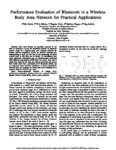Performance Evaluation of Bluetooth in a Wireless Body Area Network for Practical Applications
| dc.contributor.author | Reich, O | |
| dc.contributor.author | Hubner, E | |
| dc.contributor.author | Ghita, B | |
| dc.contributor.author | Wagner, M | |
| dc.contributor.author | Schafer, J | |
| dc.date.accessioned | 2021-05-18T11:49:45Z | |
| dc.date.available | 2021-05-18T11:49:45Z | |
| dc.date.issued | 2020-06 | |
| dc.identifier.isbn | 9781728119465 | |
| dc.identifier.issn | 1551-2282 | |
| dc.identifier.issn | 2151-870X | |
| dc.identifier.uri | http://hdl.handle.net/10026.1/17132 | |
| dc.description.abstract |
This work focuses on practical research in the field of Bluetooth 5.0 and the maximum number of Bluetooth sensors nodes in a wireless body area network (WBAN) for human activity recognition (HAR). As network topology M:1 multi-pairing is used. For the best of our knowledge no direct related work in this field can be found. We investigated how many Bluetooth connections can be simultaneously connected with different smartphones (iOS) with real sensor data and in which time intervals the data can still be processed and stored. Our results show that a maximum of 14 Bluetooth devices can be connected under practical conditions. A stable transmission with 48 bytes per package are found with most reliability in an minimal interval of 40 ms per node. | |
| dc.format.extent | 1-5 | |
| dc.language.iso | en | |
| dc.publisher | IEEE | |
| dc.subject | Bluetooth | |
| dc.subject | Internet of Things (IoT) | |
| dc.subject | performance-evaluation | |
| dc.subject | wireless body area network (WBAN) | |
| dc.subject | Special Interest Group (SIG) | |
| dc.subject | NINA | |
| dc.subject | sensor networks | |
| dc.title | Performance Evaluation of Bluetooth in a Wireless Body Area Network for Practical Applications | |
| dc.type | conference | |
| dc.type | Conference Proceeding | |
| plymouth.author-url | https://www.webofscience.com/api/gateway?GWVersion=2&SrcApp=PARTNER_APP&SrcAuth=LinksAMR&KeyUT=WOS:000681687600155&DestLinkType=FullRecord&DestApp=ALL_WOS&UsrCustomerID=11bb513d99f797142bcfeffcc58ea008 | |
| plymouth.date-start | 2020-06-08 | |
| plymouth.date-finish | 2020-06-11 | |
| plymouth.volume | 2020-June | |
| plymouth.publisher-url | https://doi.org/10.1109/SAM48682.2020 | |
| plymouth.conference-name | 2020 IEEE 11th Sensor Array and Multichannel Signal Processing Workshop (SAM) | |
| plymouth.publication-status | Published | |
| plymouth.journal | 2020 IEEE 11th Sensor Array and Multichannel Signal Processing Workshop (SAM) | |
| dc.identifier.doi | 10.1109/sam48682.2020.9104399 | |
| plymouth.organisational-group | /Plymouth | |
| plymouth.organisational-group | /Plymouth/Faculty of Science and Engineering | |
| plymouth.organisational-group | /Plymouth/Faculty of Science and Engineering/School of Engineering, Computing and Mathematics | |
| plymouth.organisational-group | /Plymouth/REF 2021 Researchers by UoA | |
| plymouth.organisational-group | /Plymouth/REF 2021 Researchers by UoA/UoA11 Computer Science and Informatics | |
| plymouth.organisational-group | /Plymouth/Users by role | |
| plymouth.organisational-group | /Plymouth/Users by role/Academics | |
| dc.identifier.eissn | 2151-870X | |
| dc.rights.embargoperiod | Not known | |
| rioxxterms.versionofrecord | 10.1109/sam48682.2020.9104399 | |
| rioxxterms.licenseref.uri | http://www.rioxx.net/licenses/all-rights-reserved | |
| rioxxterms.type | Conference Paper/Proceeding/Abstract |


